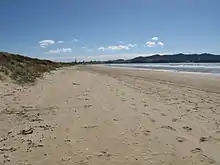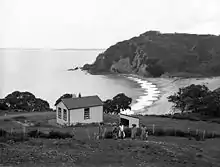Whatuwhiwhi
Whatuwhiwhi is a settlement at the northern end of Tokerau Beach, on the Karikari Peninsula of Northland, New Zealand. To the south is Doubtless Bay.[1][2] Kaitaia is about 39 km away.
Whatuwhiwhi | |
|---|---|
 Whatuwhiwhi | |
| Coordinates: 34°52′30″S 173°23′24″E | |
| Country | New Zealand |
| Region | Northland Region |
| District | Far North District |

There are three shaded and sandy coves. Swimming is safe, but it is not a good anchorage because it is exposed to the south-east.[3]
de Surville
French explorer Jean-François-Marie de Surville and his crew in the ship St Jean Baptiste were the first Europeans to enter Doubtless Bay, just 8 days after James Cook had named it. They anchored off Rangiawhia Pa, just north east of Whatuwhiwhi, on 17 December 1769, and gathered cresses and green plants from the shore. Here Father Paul-Antoine Léonard de Villefeix (chaplain on the St Jean Baptiste) conducted the first Christian service in New Zealand waters when he celebrated Mass on Christmas Day 1769. A storm on 27 December stranded a party of men on shore at Whatuwhiwhi, where they were treated hospitably by the local Māori. In the same storm, the ship dragged her anchors, which had to be cut.[4] The ship's yawl, which was in tow, struck rocks and was also cut free.
After the storm, and the stranded party had returned to the ship, on 31 December 1769, the yawl was spotted ashore on Tokerau Beach surrounded by Māori, and an armed party set off to retrieve it. They found a group of Māori carrying spears, and the chief, Ranginui, approached de Surville carrying a twig of green leaves as a sign of peace. De Surville arrested Ranginui for the theft of his boat. His party burned about 30 huts, destroyed one canoe filled with nets, and confiscated another. They brought Ranginui back to their ship, where the crew members who had been stranded during the storm identified him as the chief who had been hospitable to them. However, De Surville was determined to keep his captive, and St Jean Baptiste sailed for Peru the same day with Ranginui on board. He died of scurvy, 12 weeks later.[5]
A plaque commemorating this visit was unveiled at Whatuwhiwhi in 1969. The anchors abandoned during the storm were located and raised in a community effort on 21 December 1974.[6][7][8]
Education

Rangiawhia Native School opened in Whatuwhiwhi on 27 January 1902. Wiremu Taua was the head teacher until 1919. This was an experiment to staff a Native School with Māori staff, and Taua was the first Māori person to become a head teacher. The school gained a reputation for excellence, and more Māori head teachers were appointed for native schools. The school gained new buildings in 1906. The average roll was 20 students.[9][10] It no longer operates.
Te Kura Kaupapa Maori o Rangiawhia is a coeducational full primary (years 1-8) school with a decile rating of 2[11] and a roll of [12](as at March 2020). It is a Kura Kaupapa Māori school which teaches fully in the Māori language.
Notes
- Peter Dowling (editor) (2004). Reed New Zealand Atlas. Reed Books. pp. map 3. ISBN 0-7900-0952-8.CS1 maint: extra text: authors list (link)
- Roger Smith, GeographX (2005). The Geographic Atlas of New Zealand. Robbie Burton. pp. map 17. ISBN 1-877333-20-4.
- Parkes, W. F. (c. 1965). The Visitors' Guide to the Far North - Mangonui County (3rd ed.). p. 27.
- One of the anchors is now in the collection of the Museum of New Zealand Te Papa Tongarewa
- Quanchi, Max (2005). Historical Dictionary of the Discovery and Exploration of the Pacific Islands. The Scarecrow Press. ISBN 0810853957.
- Parkes, pp 23-25
- Michael King (2003). The Penguin History of New Zealand (7th ed.). pp. 109–110. ISBN 0-14-301867-1.
- A less formal account of the visit can be found in Gary Webb's poem, Surville at Doubtless Bay
- "Rangiāwhia school, about 1906". Te Ara: The Encyclopedia of New Zealand.
- "Taua, Wiremu Hoani 1862 - 1919". Dictionary of New Zealand Biography.
- Education Counts: Te Kura Kaupapa Maori o Rangiawhia
- "New Zealand Schools Directory". New Zealand Ministry of Education. Retrieved 26 April 2020.
External links
- Robert McNab (1914). "Chapter III — De Surville Visits Doubtless Bay, 1769". From Tasman To Marsden: A History of Northern New Zealand from 1642 to 1818.
- de Surville's Anchor